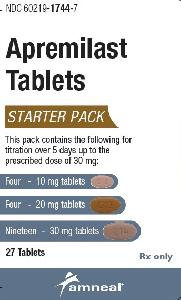Apremilast Disease Interactions
There are 3 disease interactions with apremilast.
Apremilast (applies to apremilast) depression
Moderate Potential Hazard, Moderate plausibility.
Apremilast therapy has been associated with adverse reactions of depression. Therapy with apremilast should be administered cautiously in patients with a history of depression and/or suicidal thoughts or behavior. Patients, their caregivers, and families should be advised of the potential for emergence or worsening of depression, suicidal thoughts or other mood changes. The need for continued treatment with apremilast should be carefully weighed against the risks.
Apremilast (applies to apremilast) renal dysfunction
Moderate Potential Hazard, High plausibility.
Increased apremilast systemic exposure has been observed in patients with severe renal impairment (CrCl < 30 mL/min). Therapy with apremilast should be administered cautiously in these patients. Initial dosage titration and maintenance dosage should be reduced in accordance with the product package labeling.
Apremilast (applies to apremilast) weight loss
Moderate Potential Hazard, High plausibility. Applicable conditions: Malnourished, Anorexia/Feeding Problems, Weight Loss/Failure to Thrive
Apremilast therapy has been associated with weight loss. During controlled clinical trials, weight reduction between 5% to 10% of body weight was reported in 10% of patients treated with apremilast compared to 3.3% of those receiving placebo. Weight change should be monitored during apremilast therapy, particularly in patients suffering from anorexia, malnutrition, or excessive weight loss. Physicians should evaluate patients for any unexplained or clinically significant weight loss, and discontinuation of apremilast should be considered if appropriate.
Switch to professional interaction data
Apremilast drug interactions
There are 113 drug interactions with apremilast.
More about apremilast
- apremilast consumer information
- Check interactions
- Compare alternatives
- Reviews (478)
- Drug images
- Side effects
- Dosage information
- Patient tips
- During pregnancy
- Drug class: antirheumatics
- Breastfeeding
- En español
Related treatment guides
Drug Interaction Classification
| Highly clinically significant. Avoid combinations; the risk of the interaction outweighs the benefit. | |
| Moderately clinically significant. Usually avoid combinations; use it only under special circumstances. | |
| Minimally clinically significant. Minimize risk; assess risk and consider an alternative drug, take steps to circumvent the interaction risk and/or institute a monitoring plan. | |
| No interaction information available. |
See also:
Further information
Always consult your healthcare provider to ensure the information displayed on this page applies to your personal circumstances.


